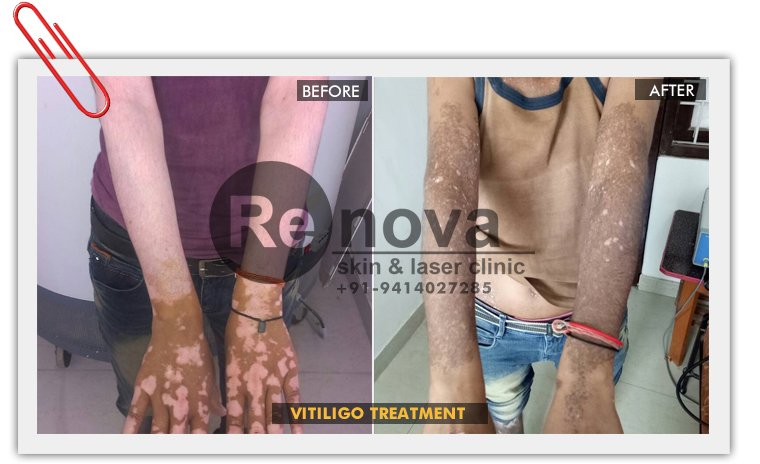Overview
Vitiligo( also known as Lecuderma, White patches or SafedDaag) is a general disorder caused by the loss of pigment melanin from the skin. Loss of color form white patches on certain sections of body parts. This prolonged de-pigmentation may affect even eye, hair and inside of the mouth.
Your skin has three layers- outer epidermis, middle dermis, and inner most subcutaneous. Melanin pigment which is the skin coloring agent is present in the epidermis. So, Vitiligo is epidermal in nature.
- Duration of Sessions
- Depends upon procedure opted
- No of Sessions Required
- Depends upon seniority of disease
- Side Effects
- Nill
- Cure / Result Time
- 6 weeks to 8 weeks
- Medicines Required
- Minimum
Treatment & Procedure
There is no 100% prevention or cure for vitiligo, but appearance of your skin can be improved to maximumby many methods such as applying sunscreen may treat the lighter spots on the skin, Phototherapy method - Exposure to Ultraviolet B and UVA lamps in skin care clinic may improve the condition, Camouflage Skin patches through corrective makeup or applying cosmetic creams, Depigmentation is a permanent solution for half body affected with vitiligo, Tattooing, Drugs like corticosteroid, calcipotriene, tacrolimus or pimecrolimus, calceneurin, etc. ointments, Afamelanotide compensation for deficient α-melanocyte-stimulating hormone
But at Renova Skin Clinic, Dr PuneetGoyal , the Vitiligo specialist treat the diseases with following methods
Reasons of Vitiligo Skin Disease
The actual cause why this disorder happens is still unknown. In a view, it is considered an autoimmune dermatological problem. The body's defense mechanism considers pigment-forming cells melanocytes as a foreign body and attacks them, thus destroying the cells. An autoimmune disease like baldness or alopecia, Hashimoto’s thyroiditis, and type 1 diabetes increase the risk of vitiligo.
Vitiligo is also related to genetics. About 25% to 50% of people worldwide suffer vitiligo before they turn 30. The reason is they have it “in their family.”
Symptoms
The only symptom of vitiligo is white marks. It is more evitable in the areas exposed to direct sunlight.
- The simple pale spot discolors to white with an increase in size
- The white spot may appear on the retina of the eye
- Pre-mature whitening or graying of hair on the scalp, eyebrow, eyelashes, and beard
- Discoloration of mucous membrane inside the mouth cavity
- In general these marks do not cause discomfort. But, some complaint about itchiness and reddening
Types of Vitiligo
It may be non-segmental or segmental. The difference lies in the origin. About 90% of cases are of non-segmental vitiligo. They develop slowly in symmetry on either side of the body. You might often observe them on arms, knees, hands, feet, nose, navel, armpits, eyes, and genital organs. Medically the condition is sub-classified as-
Localized: Few patches appear only on some area of the body. This is further diversified as Acrofacial and Mucosal.
Generalized: It is the most common subtype. Scattered patches appear on the body.
Universal: This is an uncommon type of vitiligo. Discoloration spreads all over the body.
Focal: This is a special case seen in kids.
The segmental vitiligo patch appears on one segment of a body. They develop fast.
Vitiligo is not life-threatening but certainly life-changing. People shy away from social gatherings and suffer from low self-esteem. In severe cases, they may develop depression. We have private counseling sessions with the patients at our skin clinic. Our coping strategy makes them meet and connect with others who are suffering from the white patch problem.
Before & After


Question & Answer
Content to be updated
Testimonials
Content to be updated
Videos
Content to be updated
Copyright �2018 RenovaSkinCare. All Rights Reserved




